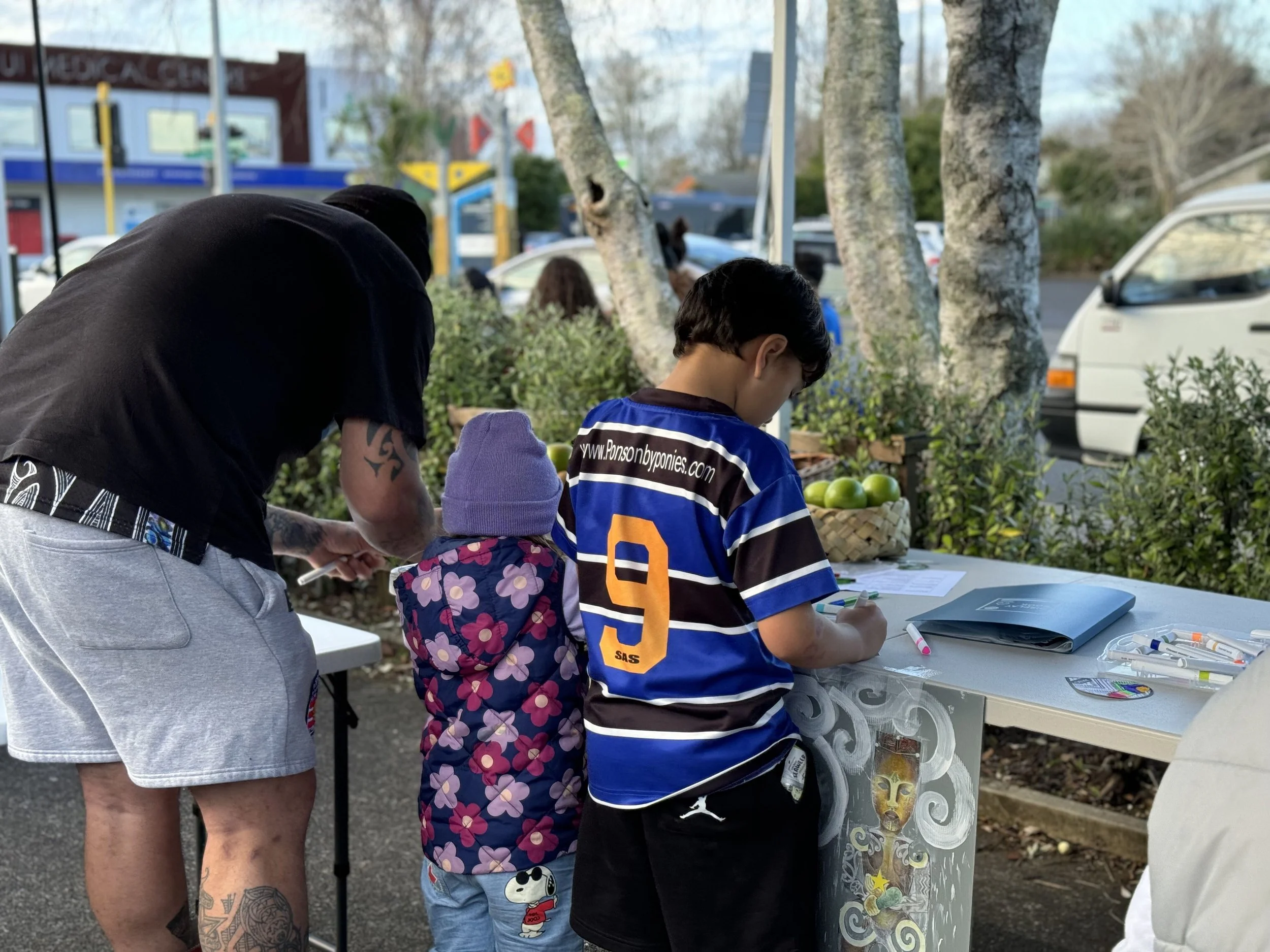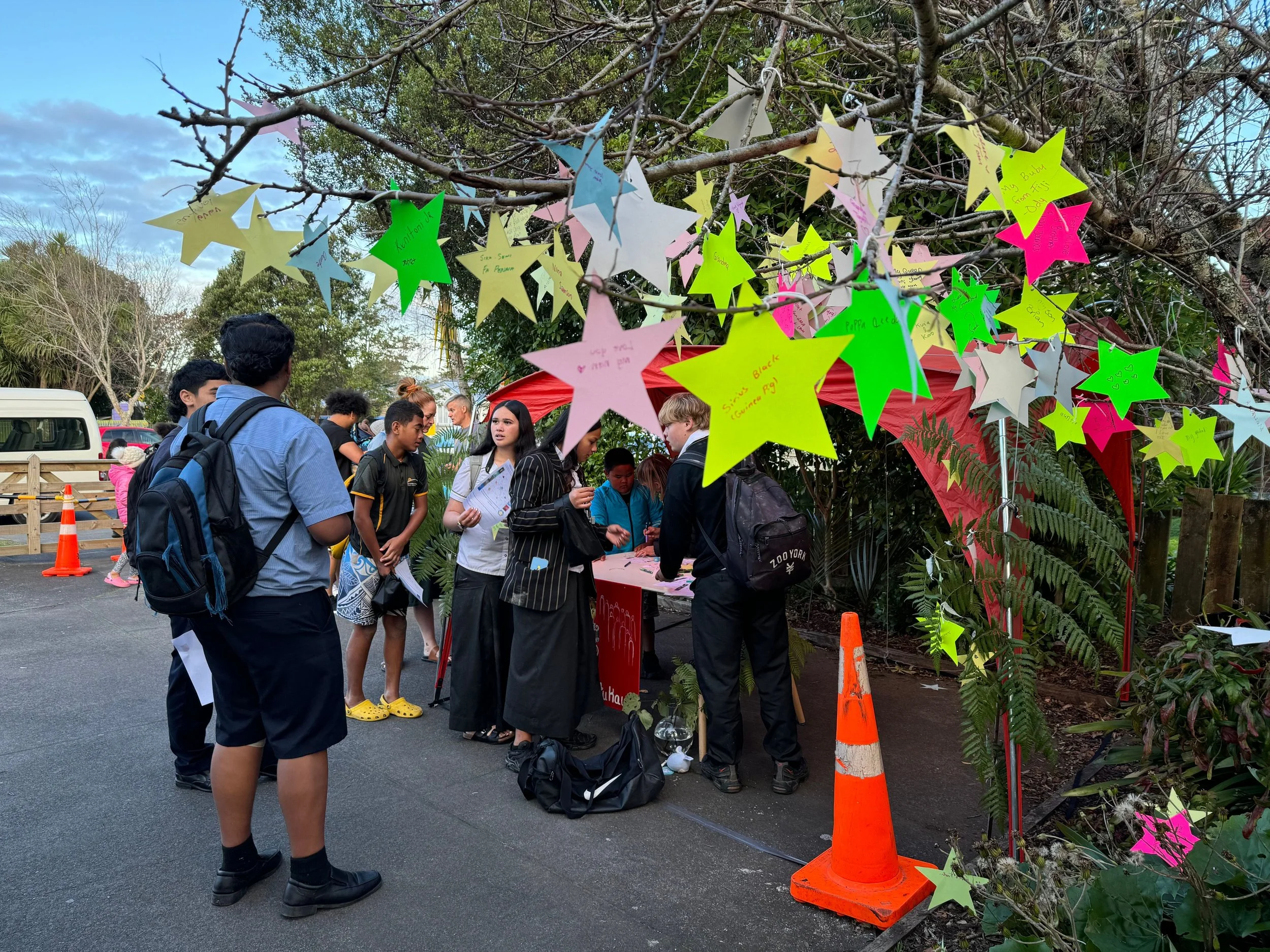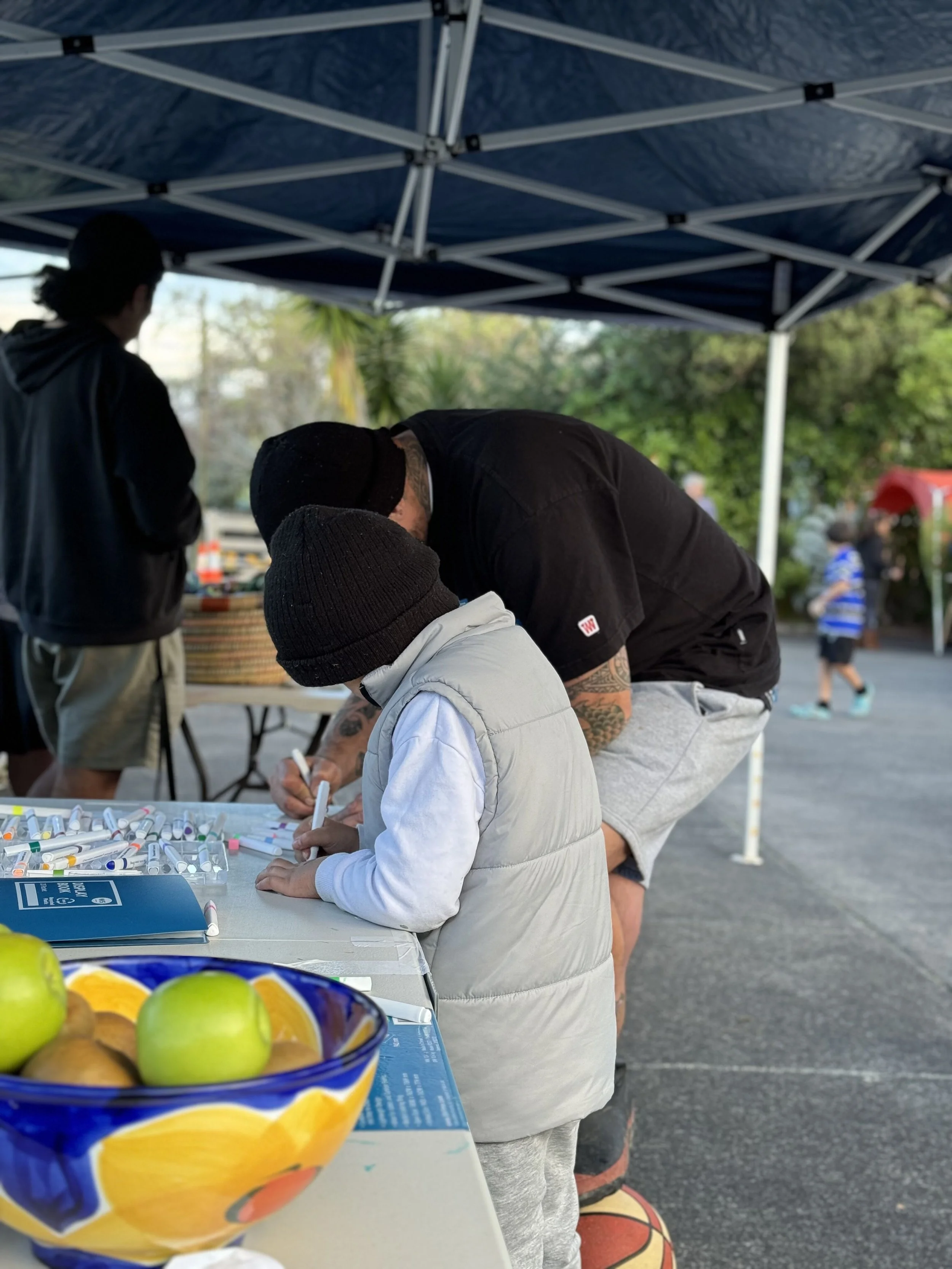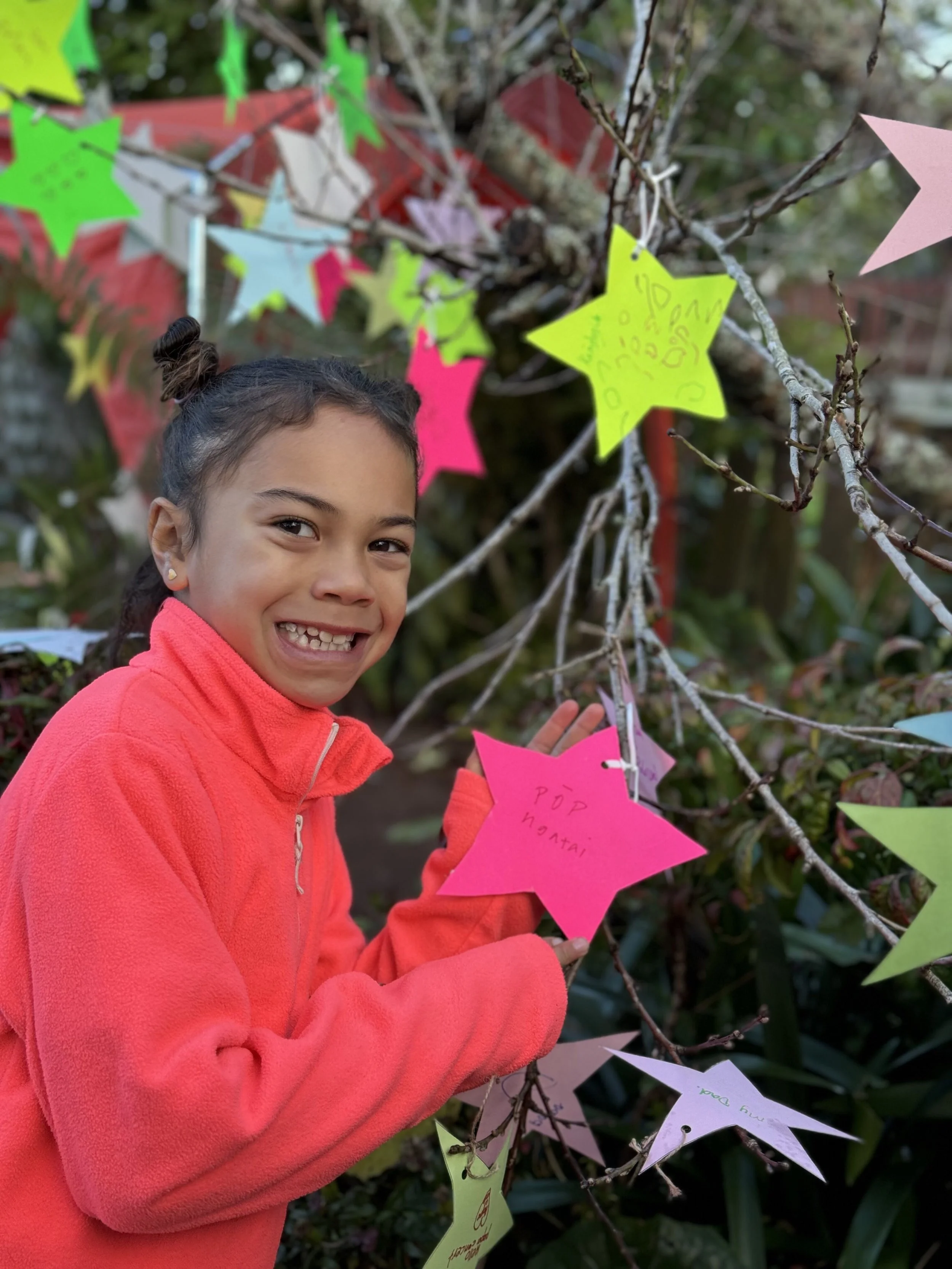Going home to Rānui

On Friday 21st June 2024 my whānau and I went along to the Manawatia a Matariki event hosted by the Rānui Action Project and Rānui 135. This prompted me to reflect on the last 12 months working in the Rānui community. To celebrate this milestone, I share images I documented at the event with some reflections on what I’ve experienced over the past year working in Rānui.
Going home to Rānui
I’ve been working in the Rānui community for over 12 months now. My colleague, mentor and hoa – Hinemoa Key connected me to mahi at the Rānui Action Project (RAP) to support the Rānui Accord – a collective of community organisations in Rānui. It was my first piece of mahi as an independent contractor.
My pēpi was 8 weeks old when we first met Carol Glamuzina (manager at RAP) and Hinemoa at the RAP whare. It is a warm and welcoming office, a space with manaakitanga at its core.
My early work with the Rānui Accord involved 1:1 kōrero with community leaders from each of the organisations who make up the collective. At the time, that included Rānui 135, Rānui Action Project, Rānui Baptist Community Care, Rānui Community Centre, Rānui Library and Rānui Primary School.
Reconnecting to my roots, it felt like a homecoming
Te Rau came to mahi with me until she was about 9 months old. In the early days she slept on me in a front pack during hui, ate solids from her pram, and rolled around at our feet during team hui. Dad picked her up and took her for walks when I had to facilitate hui. As she got older, I dropped her at mum and dad’s whare down the road from the RAP office, so I could focus, and she could have the stimulation she needed.
I grew up in Rānui and a lot of my whānau still live there – mum and dad in our whānau home with my niece, next door is my older sister and niece, and over the train tracks up on the hill is my younger sister and her husband. My sisters and I went to Rānui Primary School spanning over a period of thirteen years and mum was on the school board for some time. My younger sisters and I were in Te Whakatipu Kākano, the te reo Māori language unit.
Although we travelled outside of Rānui for intermediate and secondary school, Rānui was very much home. As an urban Māori whānau, we planted our roots in the hapori of Te Whakatipu Kākano. Many of those whānau are still in Rānui today and some followed the same pathway we did on to Te Whānau Pounamu at Kowhai Intermediate School and Ngā Tūmanako o Kahurangi at Auckland Girls’ Grammar Schol. We are still connected to many of the kaiako, mātua and school friends from those times.
Grass roots community development
Since I started my professional career at Auckland Council and later at the Tāmaki Regeneration Company, I had craved working on the ground in and alongside community. I always found myself in roles that orientated to internal systems change over community development.
I didn't study community development and it’s a term I use loosely amongst certain audiences to help describe some of the mahi I do and the kaupapa I am involved in or are passionate about. When I reflect on how I landed in this type of mahi I can’t help but think of my parents and the other mātua and kaiako that raised me. Their service, investment and contribution in everything we did as tauira Māori. Making kai for shared lunches, driving us all over Tāmaki and Te Ika ā Maui for kapa haka, whānau hui, countless wānanga in the kitchen or making kākahu kapa haka, fundraising events, prizegiving's, formal dinners, noho marae...the list goes on.
What it means to be kaupapa-driven
From what I’ve learnt within my own hapori, community development is about kaupapa and whānau. A collective of people coming together around a purpose or cause.
Here are some of the principles and practices I witnessed growing up in these hapori:
Whanaungatanga – Whānau connecting over a kaupapa
Mahitahi – Whānau working together for a kaupapa
Tamariki mokopuna – Whānau and kaupapa prioritising tamariki and mokopuna
Manaakitanga – Whānau sharing generously to contribute to the kaupapa (skills and resources)
Manawanui – Dedication, commitment and consistency to the kaupapa and whānau
Mana whakahī – Pride and ownership, repping the kaupapa and whānau
Mana whakatipu – Leadership and collective responsibility
Wānanga – Collective decision-making and problem solving that centres the kaupapa and whānau
Rautaki – Strategising and having a plan for the kaupapa and whānau to succeed
Whakanuia – Celebrating and sharing the stories of kaupapa and whānau
Kaitiakitanga – Succession planning for the sustainability and legacy of the kaupapa and whānau
These principles, modelled by my parents and wider hapori, form the foundation of my own community development practice.
Bringing power back to the community
What stuck with me most in earlier kōrero with community leaders in Rānui was their drive to bring power back to the community. From what they shared, there is a long whakapapa of external agencies or organisations coming into Rānui to ‘take’ community voice. When there is no change or response to voices shared, community leaders are left feeling unheard and unsatisfied. The needs and aspirations of the community often unmet.
I approach my mahi believing that the people I support have the answers. Walking alongside the Rānui Accord, part of my role has been to activate the power in the collective. Growing collective ownership of what’s special about Rānui, how they work together and what they work towards. Building on this to advocate and extend their influence.
In previous roles, as much as I wanted to represent and advocate for the communities I served, I was accountable to the government organisation I worked for. In this mahi, I’m accountable to the community. Typically, you might see my role as a project manager, but I see it as a community advocate, systems navigator, connector, weaver and sense-maker. My experience working ‘in the system’ enables me to navigate bureaucracy and challenge the public service to work in ways that privilege the community and more specifically Te Tiriti and kaupapa Māori.
Supporting community to lead
I’m proud of the mahi we’ve achieved together in Rānui over the last 12 months. Having a dedicated and shared resource to provide backbone support for the Rānui Accord has made a difference. We have demonstrated what happens when you prioritise whanaungatanga and relationships. Building trust between leaders and organisations, and setting a strong foundation for our work together.
I want to acknowledge Hinemoa Key, Repeka George-Koteka (Ei’Moana Consultants) and Annalise Myers (Point Associates) who have walked alongside us over this time.
Led by the Rānui Accord, we’ve worked together to:
Bring community leaders together through whanaungatanga and build a strong foundation for collaboration.
Refresh the purpose and tikanga of the collective and identify collective priorities through an action plan.
Design and deliver community-led research and engagement with the support of Point Associates.
Design and deliver a community event that celebrates community resilience and spirit with the support of Ei’Moana Consultants.
Influence the design of the Rānui Domain Playground upgrade to reference local stories of people and place and reconnect with Te Kawerau ā Maki.
Develop a report ‘by Rānui, for Rānui’ that captures community voice, aspirations and needs.
Beyond this, we’ve built momentum and shifted the energy, drawing on the mauri of Rānui. I hope my mahi with RAP and the Rānui Accord continues over the next year and I welcome the new experiences and learnings along the way.
He aroha whakatō, he aroha puta mai

Manawatia a Matariki Event, Rānui Action Project | 21.06.24 | Shot on Apple iphone 15 Pro










